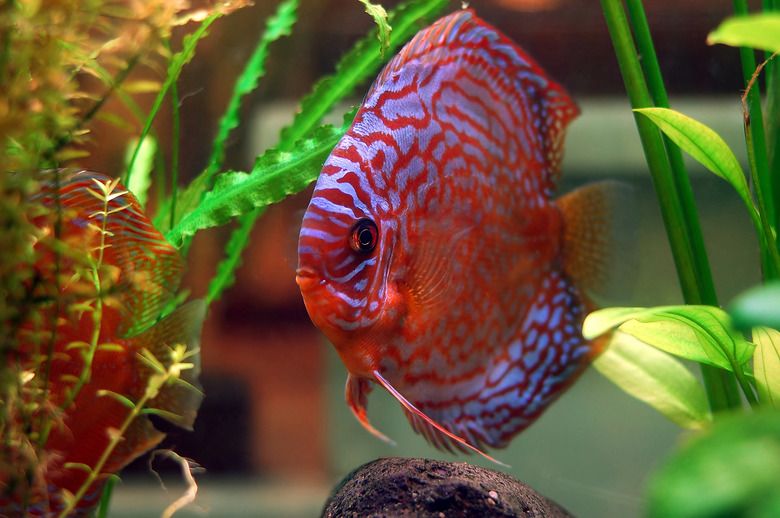How To Tell If A Discus Fish Is A Male Or A Female
Discus fish are among the most popular fish breeds because of their unique body shape and their wide range of colors and patterns. If you're planning to fill your aquarium by raising your own discus fish fry to adulthood, it's important to know how to tell discus male and female fish from one another by observing slight physical and behavioral differences.
Discus size matters
Discus size matters
Until discus fish are 4 inches or more, it's impossible to discern a discus male and female. That's because fish who are smaller are sexually immature and haven't developed the traits that would let you differentiate gender. You might have to wait a while until your discus fish is large enough to sex, as it can take discus fish two or more years to reach their full size of 6 inches.
Although discus fish aren't usually referred to as cichlids, they are a member of the Cichlidae family and share many traits common to the species. Like most cichlids, the male discus fish is bigger than the female at sexual maturity. However, in order for size to be a useful determinant of gender, your discus fish should all be purchased at the same time and at the same approximate size.
Size, however, is not always a reliable indicator of gender. The biggest fish is usually the most aggressive male who consequently has access to more food. However, subordinate males and tank females could be about the same size, causing a misidentification of gender.
Sexing discus fish visually
Sexing discus fish visually
As discus fish sexually mature, male and female discus fish develop slight physical differences that can give you a clue to their gender. Besides being larger, male discus fish develop thicker lips. These bigger lips help defend their chosen female against other males who would try to take the female for their own. Males also have a more prominent forehead, sometimes used as a battering ram to give interloping males the boot.
Although male discus fish have prominent physical characteristics, the female usually has the most striking coloration in solid-colored fish, while the male's colors appear more faded. In patterned species, the male has more intricate patterns than the female. Fin shape is another clue. As males mature, the tip of their fins becomes pointy instead of its formerly round shape. A female's fins stay round throughout life.
Watching discus fish behavior can also lend a clue to their gender. Males tend to be more nippy, especially when potential rivals approach their chosen female. They might also position themselves as a blockade between the female and other fish. A female will tend to swim around behind the male and usually stays close by his side.
Obtaining discus males and females
Obtaining discus males and females
Discus fish can be expensive — up to around $150 each — so it makes sense to try to build your own breeding stock. Young fish are much less expensive — usually under $20 for quality fish. By purchasing a dozen discus fish of the same strain as young fish, you'll likely get one or more breeding pairs from the group.
Beware of cheap discus fish that aren't perfectly round if you plan to raise stock to sell. Some inexpensive fish are injected with color dye or growth hormones and have a shortened life span. Fish injected with hormones are sometimes infertile and won't reproduce.
At what age do discus start breeding? Females can start when they are around 9 months of age, but it could take a male up to 13 months. A female discus lays eggs on the bottom of the tank, and the male discus fish swims over them to fertilize them. If you have two discus and see eggs but they never hatch, chances are they are both females. Likewise, if you have a dominant male and a subordinate male, they could visually appear to be a discus male and female, but you'll never see eggs.
